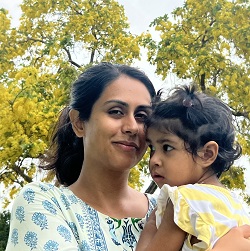2023 Irene Adler Prize
 Shannan Mann is the winner of the 2023 Irene Adler Prize for women writers for her essay, “All Blue, Ana.” It appears below.
Shannan Mann is the winner of the 2023 Irene Adler Prize for women writers for her essay, “All Blue, Ana.” It appears below.
Mann, who will receive $1,000 toward her education, is seeking her B.A. at the University of Toronto (English Specialist). This is the first time the annual essay competition — founded in 2017 — has welcomed entries from contestants worldwide as well as the U.S. and Canada.
Honorable mentions go to:
Sophia DuRose (“Music, Baby!”), who is pursuing her M.F.A. in poetry at Temple University.
Madison Kunz (“A Swing-Set Goodbye”), who is doing her B.A. in English literature at Queens University.
All Blue, Ana
By Shannan Mann
Seven seconds old Ana resembles storm-clouds, midnight seen through insomnia, branches of veins under skin, blue-whale flesh. Babies are not meant to be blue. Anasuya is blue because she is struggling to breathe. Her eyes are open — black and alive.
I am alone, blue-gowned, in a small curtained space. Both my hands are needled with IV tubes. A heart and oxygen monitor whimpers beside the bed.
A deep stirring movement where the uterus lies, like ladle scrapes in a pot. An absence of sensation below the abdomen — akin to hunger, a cousin to frostbite, beginning blue around the toenails and fingernails and radiates outward in a compass of colour — white, smoke, ash.
I want Anasuya’s body on my body, skin to skin, blue or pink. After five hours and thirty-two minutes I am sanctioned to see her.
A yellowed hand attaches a fluorescent pad to a bouquet of cords in her belly button. I am jealous of the hand. I want to gnaw it away. My baby. Your baby is very sick, a doctor tells me with clinical dispassion.
So I hold her with my eyes — twin moons, fish fins, dark as doubt. I tell her it’s going to be alright because this is the unedited script given to all parents with dying children.
They take her to a hospital nine miles away. The sky outside is blue and yellow and not the least bit aware that it ought to be crackling and black.
She is salt in the sea, invisible but everywhere.
I experienced her first as a ClearBlue flash, then a wild-horse heartbeat on a doppler, bone and pixel diagram on ultrasound, widening birdwing-beat against ribcage and bladder, a name sung in a dream, and now as a blue child with black eyes.
That pain in itself is not painful — but the impatience that comes with it, the desperation for it to pass, the unknowing, the wolf-eaten calendar, the dream-drawn hourglass.
No suffering lasts. Either the sufferer will die, or the suffering will. Anasuya and I are home in a handful of days as though nothing happened. And maybe nothing did. Birth, after all, appears inconsequential in the face of death. Yet, the horror of those first seconds lives in our dual-dreamland. We weep together. Then we rescue each other, her nine-day-old palms in my nine-thousand-day-old palms.
By month’s end, I take her to the coast. I whisper into her small conch shell ear that the ocean is not really blue, but only appears so because it reflects the glimmering sapphire sky in its watery heart. Like water and light, we can also reflect within us all the hope and beauty of the world and cascade, beat, wave, blue and brilliant against the pale, cold, white, harsh, immeasurable truths of the ceaseless world. Ana chortles, as if in agreement.
